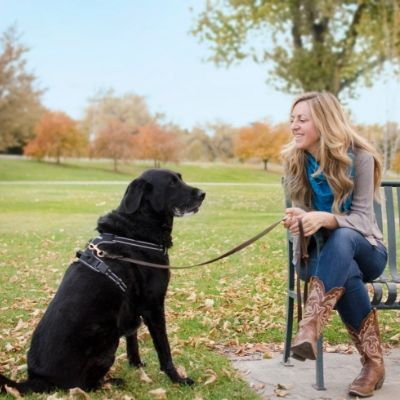Join me as I interview Emily Tronetti, owner of Coexistence Consulting in Bellevue, WA, on the Paws & Reward Podcast today. We discuss two of my favorite topics: the human-canine bond and how to care for ourselves so we can support our best friends.
Emily is an anthrozoologist as well as a certified dog trainer. She offers training, consulting, and education to pet professionals and parents. Since childhood, her relationships with animals have been so important to her emotional wellbeing and mental health.
She ended up pursuing a career in dog training while also attending the graduate program in Anthrozoology at Canisius College. Anthrozoology is the study of the relationships and interactions between humans and other animals.
How would you define the human-canine bond?
Emily says, “The human-canine bond can be hard to define. On an individual level, it’s a very personal experience. Based on my experience and education, I define the human-canine bond as a mutually beneficial relationship in which both the dog and the human are experiencing positive welfare.”
What is the science behind the human-canine bond?
Emily says, “From a scientific perspective, research on the human-canine bond is still pretty new. The research that’s been done so far is uncovering many interesting things about the relationships between dogs and their humans.”
Domestication of dogs research:
- Dogs were the first nonhuman animals to be domesticated somewhere between 15,000 and 40,000 years ago (Prassack et al., 2020).
- During the domestication of dogs, these canines underwent several changes. How they looked changed, and there were also developmental, social, cognitive, and behavioral changes that took place. Over time, dogs further developed skills that have allowed them to have such a cooperative, close relationship with humans and began to build the human-canine bond (Bentosela et al., 2016; Heberlein et al., 2016; Lampe et al., 2017; Range, et al., 2019).
Research on the human-canine bond:
- Dogs can follow human pointing gestures as early as four months old, even without intensive socialization earlier in life (Virányi et al., 2007). Dogs can also interpret the direction of our gaze and have demonstrated an ability to communicate with humans using gaze (Johnston et al., 2017; Nagasawa, et al., 2009). For example, if dogs are struggling to solve a task, they’ll gaze at humans to request their assistance – a simple but profound example of the human-canine bond.
- In addition to their attention to our gaze, studies suggest that dogs can also interpret human emotions by discriminating our facial expressions, our posture, our vocalizations as well as our odor and chemical signals (Albuquerque et al., 2016; Siniscalchi et al., 2016; D’Aniello et al., 2018; Siniscalchi et al., 2018).
- There’s also some interesting research demonstrating that there is an emotional contagion from guardian to dog (Katayama et al., 2019). Emotional contagion is a primitive form of empathy, it’s the mirror of emotional states between individuals (Sundman et al., 2019). One example of this is yawning. Some dogs yawn when they see their guardians yawn. One study found that the strength of the emotional contagion between dogs and their guardians increased the longer the dog lived with their guardian in addition to how much time they spent with each other day to day.
- Another study from last year determined that “dogs, to a great extent, mirror the stress levels of their owners” (Sundman et al., 2019). More specifically, they found that the stress hormone levels of dogs and their guardians synchronize over time. A number of factors correlated with this, such as gender, lifestyle, and the guardian’s personality. The researchers discussed how it seems that humans who have high Neuroticism scores on personality tests form strong attachment bonds to their dogs. They also tend to rely more on their dog for social support while also serving as a social supporter for their dog. The researchers said that this may have a positive effect on both the human and their dog’s stress.
This last point especially shows exactly why taking care of yourself can have a significant impact on the human-canine bond that we form with our dogs.
Because our bond is so strong and we’re in concert with one another, how can we support ourselves to protect this bond? Use these tips from Emily below to support yourself – and your dog.

How to Build the Human-Canine Bond With Your Dog
#1: Know that you (and your dog) are going to make mistakes.
Many of us pressure ourselves to be perfect not only in our work but in our relationships. Emily comments, “Perfection is not real, and mistakes are just information. They’re just a part of the process of making progress.” One way to be kinder to yourself is recognizing when there is blame or shame in your self-talk and reframing that language. This can have a big impact on the human-canine bond.
#2: Know what triggers you so we can be aware of the possible projections.
Dogs know how we are feeling, whether that’s through our body language, our facial expressions, or how we smell, so being aware of when we are stressed is critical for the relationship.
Stress influences our body language and behavior, which can negatively impact our dog’s behavior. As trainers, we talk a lot about trigger stacking and keeping dogs under emotional threshold.
This concept also applies to humans. Practice checking in with yourself and getting to know your own triggers so you can also identify when you’re approaching emotional threshold.
#3: Resource yourself to enhance the human-canine bond.
Fill up your cup!! With whatever makes you feel capable, rested, and resourced. This could mean saying no to something or saying yes to someone. It might mean noticing you’re getting frustrated and dealing with that emotion away from your dog so it does not negatively impact them.
#4: Know when to ask for help.
Asking for help does not make you a failure. We cannot know it all, we cannot do it all. We all need support sometimes, even when building a human-canine bond. So, if you don’t have the answer, if you think you might need help, don’t hesitate to reach out to someone who can. That might be a veterinarian, a dog trainer, your spouse, family member or friend.
Other Resources to Build the Human-Canine Bond
To learn more about Emily and her work with dogs and pet parents, please visit Emily’s website: www.coexistence.consulting. And if you’re ready to start building your connection with your dog, explore Paws and Reward’s Six Connection Principles or our online The Connection Summit course.
Get notified when new episodes drop so you don’t miss a thing!
References:
Albuquerque, N., Guo, K., Wilkinson, A., Savalli, C., Otta, E., & Mills, D. (2016). Dogs recognize dog and human emotions. Biology Letters, 12(1), 20150883. https://doi.org/10.1098/rsbl.2015.0883
Beetz, A., Uvnäs-Moberg, K., Julius, H., & Kotrschal, K. (2012). Psychosocial and Psychophysiological Effects of Human-Animal Interactions: The Possible Role of Oxytocin. Frontiers in Psychology, 3. https://doi.org/10.3389/fpsyg.2012.00234
Bentosela, M., Wynne, C. D. L., D’Orazio, M., Elgier, A., & Udell, M. a. R. (2016). Sociability and gazing toward humans in dogs and wolves: Simple behaviors with broad implications. Journal of the Experimental Analysis of Behavior, 105(1), 68–75. https://doi.org/10.1002/jeab.191
Crawford, E. K., Worsham, N. L., & Swinehart, E. R. (2006). Benefits derived from companion animals, and the use of the term “attachment.” Anthrozoös, 19(2), 98–112. https://doi.org/10.2752/089279306785593757
D’Aniello, B., Semin, G. R., Alterisio, A., Aria, M., & Scandurra, A. (2018). Interspecies transmission of emotional information via chemosignals: From humans to dogs (Canis lupus familiaris). Animal Cognition, 21(1), 67–78. https://doi.org/10.1007/s10071-017-1139-x
Hall, N. J., Liu, J., Kertes, D., & Wynne, C. D. L. (2016). Behavioral and Self-report Measures Influencing Children’s Reported Attachment to Their Dog. Anthrozoös, 29(1), 137–150. https://doi.org/10.1080/08927936.2015.1088683
Heberlein, M. T. E., Turner, D. C., Range, F., & Virányi, Z. (2016). A comparison between wolves, Canis lupus, and dogs, Canis familiaris, in showing behaviour towards humans. Animal Behaviour, 122, 59–66. https://doi.org/10.1016/j.anbehav.2016.09.023
Howie, A., Fine, A., & Rojas, L. (2019). Why the Dog? In Transforming Trauma: Resilience and Healing Through Our Connections With Animals (pp. 299–326). Purdue University Press.
Johnston, A., Turrin, C. L., Watson, L., Arre, A., & Santos, L. (2017). Uncovering the origins of dog–human eye contact: Dingoes establish eye contact more than wolves, but less than dogs. Animal Behaviour. https://doi.org/10.1016/J.ANBEHAV.2017.09.002
Katayama, M., Kubo, T., Yamakawa, T., Fujiwara, K., Nomoto, K., Ikeda, K., Mogi, K., Nagasawa, M., & Kikusui, T. (2019). Emotional Contagion From Humans to Dogs Is Facilitated by Duration of Ownership. Frontiers in Psychology, 10. https://doi.org/10.3389/fpsyg.2019.01678
Lampe, M., Bräuer, J., Kaminski, J., & Virányi, Z. (2017). The effects of domestication and ontogeny on cognition in dogs and wolves. Scientific Reports, 7(1), 11690. https://doi.org/10.1038/s41598-017-12055-6
Mills, D., & Hall, S. (2014). Animal-assisted interventions: Making better use of the human-animal bond. Veterinary Record, 174(11), 269–273. https://doi.org/10.1136/vr.g1929
Nagasawa, M., Mogi, K., & Kikusui, T. (2009). Attachment between humans and dogs. Japanese Psychological Research, 51(3), 209–221. https://doi.org/10.1111/j.1468-5884.2009.00402.x
Payne, E., Bennett, P. C., & McGreevy, P. D. (2015). Current perspectives on attachment and bonding in the dog–human dyad. Psychology Research and Behavior Management, 8, 71–79. https://doi.org/10.2147/PRBM.S74972
Payne, E., DeAraugo, J., Bennett, P., & McGreevy, P. (2016). Exploring the existence and potential underpinnings of dog–human and horse–human attachment bonds. Behavioural Processes, 125, 114–121. https://doi.org/10.1016/j.beproc.2015.10.004
Prassack, K. A., DuBois, J., Lázničková-Galetová, M., Germonpré, M., & Ungar, P. S. (2020). Dental microwear as a behavioral proxy for distinguishing between canids at the Upper Paleolithic (Gravettian) site of Předmostí, Czech Republic. Journal of Archaeological Science, 115, 105092. https://doi.org/10.1016/j.jas.2020.105092
Range, F., Marshall-Pescini, S., Kratz, C., & Virányi, Z. (2019). Wolves lead and dogs follow, but they both cooperate with humans. Scientific Reports, 9(1), 3796. https://doi.org/10.1038/s41598-019-40468-y
Siniscalchi, M., d’Ingeo, S., & Quaranta, A. (2016). The dog nose “KNOWS” fear: Asymmetric nostril use during sniffing at canine and human emotional stimuli. Behavioural Brain Research, 304, 34–41. https://doi.org/10.1016/j.bbr.2016.02.011
Siniscalchi, M., d’Ingeo, S., & Quaranta, A. (2018). Orienting asymmetries and physiological reactivity in dogs’ response to human emotional faces. Learning & Behavior, 46(4), 574–585. https://doi.org/10.3758/s13420-018-0325-2
Sundman, A.-S., Van Poucke, E., Svensson Holm, A.-C., Faresjö, Å., Theodorsson, E., Jensen, P., & Roth, L. S. V. (2019). Long-term stress levels are synchronized in dogs and their owners. Scientific Reports, 9(1), 7391. https://doi.org/10.1038/s41598-019-43851-x
Virányi, Z., Gácsi, M., Kubinyi, E., Topál, J., Belényi, B., Ujfalussy, D., & Miklósi, A. (2008). Comprehension of human pointing gestures in young human-reared wolves (Canis lupus) and dogs (Canis familiaris). Animal Cognition, 11(3), 373–387. https://doi.org/10.1007/s10071-007-0127-y

